Introduction
The following pages do not contain the whole of the tale. You must have a copy
of the Mabinogi (unabridged if possible, but it does
not matter which version) and any modern Ordnance Survey
maps of the areas under consideration. But remember
that the book was originally written in Middle Welsh,
so the spellings are likely to vary between each
version
according to the editor's choice.
Branches 1, 2 & 3 of the Mabinogi do not contain as many place-names as the 4th branch which
was largely set in Gwynedd. But this does not mean
that the writers were less familiar with places outside
Gwynedd. Words, idioms and pronunciation by writers
who were obviously from South Wales characterize the
whole work. After all, it was not the chief purpose
of the story-tellers and later, scribes to give a detailed
geographical description of Wales Of Old: the story
itself was all.
The Four Branches of the Mabinogion form a complete work, not four separate parts.
Only one character, Pryderi, appears in all four parts.
The stories appear disconnected at times because, according
to many scholars, some connecting tales have been lost
over the centuries, but one theme connects the whole
work – the life of Pryderi.
Yet it is possible to find additional information about places by looking closely
at personal names. Sometimes some of the names appear
to be unreal, perhaps the correct ones having been
forgotten over the centuries. Therefore it is likely
that the names were created to contain some of the
attributes and origins of the character: e.g. Pwyll
and Pryderi (“Sense” and “Concern”)
As with the fourth branch, we must bear in mind the nature of mediaeval society
and its attitude to ages past. Often, its recent, as
well as ancient, history is mingled with traditions
which are likely to have had its origins in prehistoric
times.
The First Branch
DYFED -
7 Hundreds (Cantrefi) (See the map of old Welsh land measurements  for further
details) for further
details)
ARBERTH -
Narberth One of Pwyll’s chief courts, obviously not
far from Gorsedd Arberth (see below). Perhaps the site
of the Norman Castle SN112145 in Arberth?
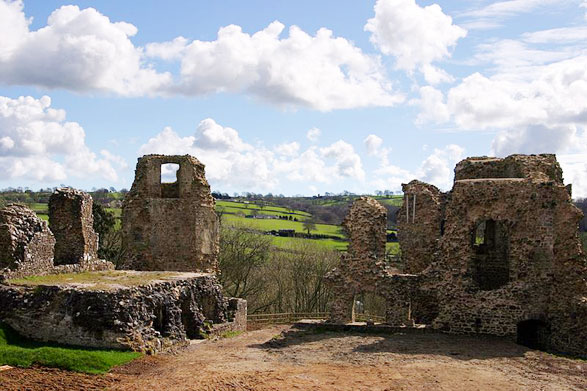
GLYN CUCH -
SN236415 i SN280358 The River Cuch (or Cych) forms
the boundary between Old Dyfed (Pembrokeshire now)
and Carmarthenshire. “And Pryderi son of Pwyll, who
kept the swine of Pendaran Dyfed in Glyncuwch in Emlyn”
from Peniarth Triads. Perhaps, in the imagination of
storyteller, Pwyll followed the old road from Arberth
through Boncath, keeping to the top of the ridge, then
down to Abercuch.
PEN LLWYN
DIARWYA - unknown. Although heroes of days gone by had supernatural powers which enabled
them to travel long distances easily, it is likely
to be near Glyn Cuch.
ANNWFN -
see Fourth Branch 
THE FORD -
SN238411 Near the village of Abercuch is an ancient
ford across the river, but looking at the O.S. map
and the aerial photo at www.cambria.org.uk  ,
it is obvious that the river which meanders through
the valley has changed course over the centuries -
note where the county boundary is now. But in the past,
it formed the boundary between Dyfed and Ystrad Tywi.
It is also near the River Teifi, which is the border
with Ceredigion. There are delightful pictures of
the Abercych area at www.headwaters.co.uk ,
it is obvious that the river which meanders through
the valley has changed course over the centuries -
note where the county boundary is now. But in the past,
it formed the boundary between Dyfed and Ystrad Tywi.
It is also near the River Teifi, which is the border
with Ceredigion. There are delightful pictures of
the Abercych area at www.headwaters.co.uk  . .
The characters never differentiate between this ford and the ford where Pwyll
killed Hafgan. Any “doorway” between two places or
any turning in the year was special in our traditions.
Also every
river was sacred to the Water Goddess according to
the Ancient Celts and no evil spirit could cross water.
GORSEDD
ARBERTH - SN113135. The Iron Age fort on Camp Hill to the south of the town of Narberth
is the most likely, but a number of places nearby
claim that honour.
This is where Pwyll first saw Rhiannon on horseback. (Her name is associated
with Rigatona/Epona, a Celtic goddess whose symbol
was a horse, the sign of power: it is said that the
old Christmas-tide custom of the “Mari Lwyd” arose
from the same source – see www.museumwales.ac.uk  . Rhiannon’s punishment
after the disappearance of her son was to carry visitors
on her back into the court
like a horse.) . Rhiannon’s punishment
after the disappearance of her son was to carry visitors
on her back into the court
like a horse.)
[There is a Nant Arberth (and also some iron age forts) to the east of Cardigan
– but they are not in Dyfed and far too close to Glyn
Cuch to fit the story.]
THE COURT OF HEFEYDD HEN (or Hyfaidd Hen) – unknown, but, according to the Mabinogion,
certainly not in Dyfed.
But according to some
other traditions, Hefeydd was the first King of Dyfed.
Gorsedd
Arberth was his burial
place and also the entrance to Annwn. Was this the
enchanted castle in the third Branch?
A hero called
Hefeydd Hir is found in the 6th century epic poem
Y Gododdin (composed by a Briton named
Aneurin who lived in a land which is now part of
Scotland).
In the second Branch of the Mabinogion he appears
as one of the Seven Knights, King Hefeydd of
Dyfed who died
in 892 etc... Hefeydd was a common name in Mediaeval
Wales.
THE KINGDOM OF
GWAWL FAB CLUD -
(see map of Scotland below). It is said that the
literal meaning of the name is “Wall Son Of Wealth”.
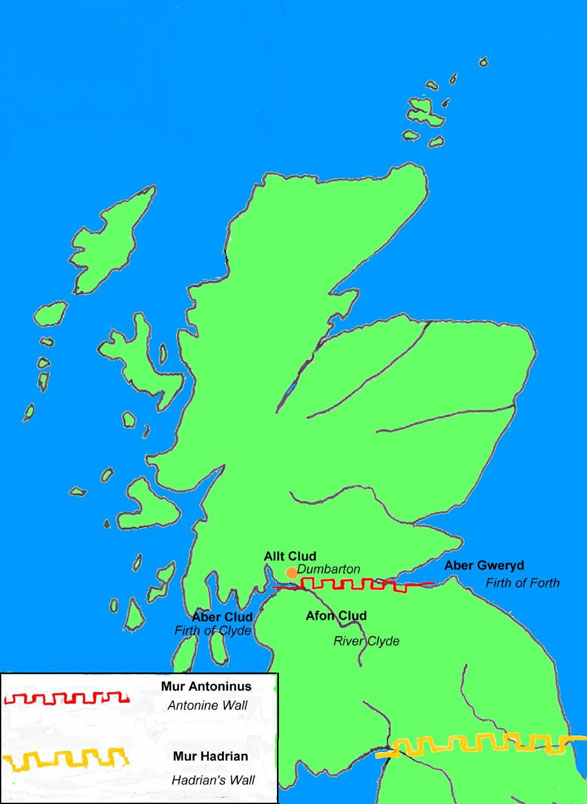
“Gwawl”, according to the University of Wales Dictionary means:
- The Vallum (Roman
wall) between the Firth of Forth and the Firth of
Clyde - the Antonine Wall, not Hadrian’s Wall
- Man
- Light
But his last name more than likely refers to the River Clyde in Scotland. Therefore
he was one of the people of the Old North, that is
to say they were Britons, like the Welsh.
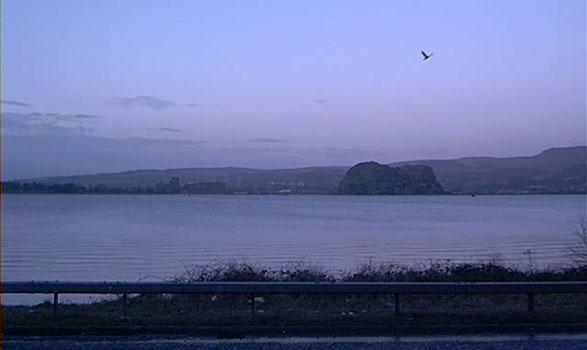
Their capital was Allt Clud – a huge rock on the further north bank of the River
Clyde. [Now called Dumbarton (City of the Britons)
Rock NS399745].
The lands of the Britonnic kingdoms stretched unchallenged from Central Scotland
to Cornwall until the Battle of Dyrham (near Bath)
in 577 and to Wales until the Battle of Chester in
615.
Strangers in our own land?
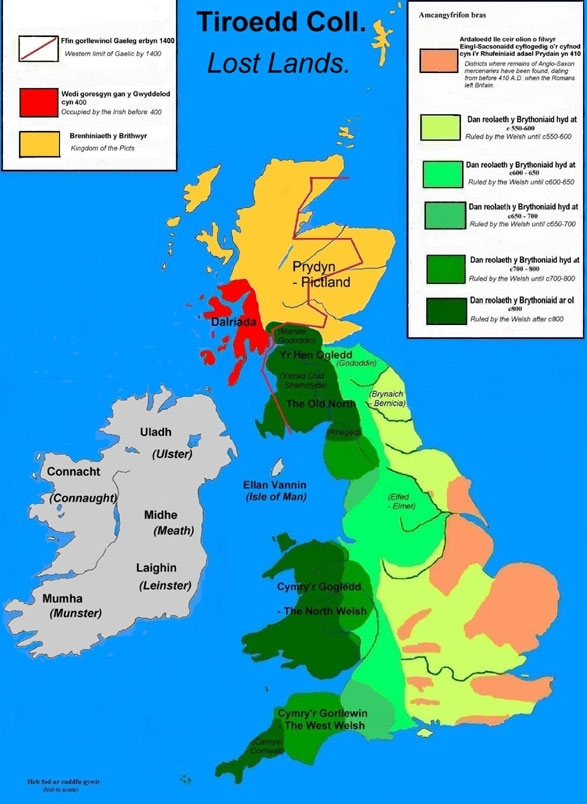
»» Click here to download a PDF version of the map  (281kb) (281kb)
The Anglo-Saxons referred to all the Britons as “Wælisc” (Welsh) that is to say
- “foreigners” who spoke another language.
They were differentiated as:
- 1. The North Welsh
– All of present-day Wales, including parts of the
Border Counties. (Welsh is spoken by 582,400 people
according to the 2001 Census.)
- 2. The West Welsh who inhabited Somerset, Devon, Dorset and their last stronghold,
Cornwall - what is now referred to as South-West
England. (Cornish, which is similar to Welsh, was
spoken up to the 18th century when the last monoglot
speaker died. But it is said that a small number
of people who had a fair grasp of it survived into
the 20th century, when the language revival began.
By now there are about 300 totally fluent speakers
and about 3,000 learners.) A large number of the
West Welsh fled to Brittany - (Breton, which is more
similar to Cornish than to Welsh, is spoken by about
270,000 according to the 2001 Census.)
- 3. The Strathclyde Welsh - who inhabited places in what is now Southern Scotland
and Cumbria in North-west England.
Some established themselves across their northern frontier in Manaw Gododdin,
the Clackmannan area of modern Scotland (from the Gaelic
Clach Mhanainn, 'Stone of Manau'). The Romans’ policy
was to encourage some of the tribes which were not
under their rule with money (and the right to keep
all the land they captured) to resist their great enemies
– in this case, to keep the Picts at a distance from
the Empire.
They were renowned soldiers and a number of them went to the lands of the North
Welsh to fight the Irish (another great enemy of the
Romans and their Brittonic successors) who had occupied
Llyn, Arfon, Arllechwedd and parts of Anglesey. According
to the monk Nennius,(writing in about the year 800)
their leader was Cunedda ap Edern, also known as Cunedda
Wledig or in Latin, Cunetacius (c.386–c. 460) He and
his eight sons and their army were from Manaw Gododdin.
After they drove out the Irish, he and his children
and granchildren ruled in many parts of Wales.
Dyma rai a roddodd eu
henwau i’w tiroedd eu hunan:
- Aflog,
who ruled Aflogion (Llŷn)
- Ceredig who
ruled Ceredigion
- Dogmael,
who ruled Dogfeiling (Dyffryn Clwyd)
- Dunod,
who ruled Dunoding (parts of Eifionydd and Ardudwy)
- Edern,
who ruled Edeirnion (Area around Corwen)
- Einion
Yrth, who ruled Caereinion (Powys)
- Rhufon,
who ruled Rhufoniog (Denbigh Area)
- Tegeingl
daughter of Cunedda, who ruled the area of modern Flintshire and beyond
- Meirion,
who founded Meirionnydd
(The River Teifi was their southern boundary - Did Gwawl fab Clud represent a
leader of the forces from Strathclyde to the inhabitants
of Dyfed?)
But Cunedda, his sons and followers were not the only ones from the Old North
who came to take possession of North Wales - Elidir
Mwynfawr, and after him Clydno Eiddyn, came with their
hosts in the 6th century. But in this instance their
efforts were all in vain. They were killed by the men
of Arfon near Clynnog. See 'Clynnog yn ein Llenyddiaeth Gynharaf Un'  . .
The Princes of Gwynedd took pride in their lineage that could be traced back
to Cunedda in the Age of the Romans. (It is said that
Edward 1st was infuriated by this.) Also it is likely
that a great number of the residents of modern Wales
are also descendents of the Welsh of Strathclyde.
In 870 Allt Clud was captured by Irish Vikings and the capital was moved south
of the River Clyde to Govan. Then the whole kingdom
was referred to as Cumbria or Rheged. In the end, the
Strathclyde Welsh themselves lost their kingdom during
the 10th and 11th centuries to two enemies:
- The Scots (Scotti
in Latin,) who were of Irish stock who perhaps settled
in parts of Western Scotland (Dalriada) in the 4th
century, bringing with them their language which
evolved into Scottish Gaelic
- The Northumbrians, who brought with them their Anglo-Saxon language which
evolved into Scots – a language very different from
modern English
But some of the Strathclyde Welsh still continued to speak their Brittonic language
(very much like Old Welsh) up to the 13th century.
The Strathclyde Welsh were referred to in Latin as ‘walensis’ in the documents
of the period and it is possible that the name Wallace
(and similar names) arose in South-West Scotland. But
the great hero of Scotland, William Wallace (1272 –
1305 who was born in Elderslie, Renfrew,) was not only
a descendent of the Strathclyde Welsh: His forefathers
came from Wales, or from a part of Shropshire where
Welsh was spoken, in the reign of David 1st 1124 –1153
and the name Wallace was given to them because they
spoke a very similar language to the that which was
spoken round about them.
Coincidence?
It is often said that Maesyfed (Radnorshire, in English) derives its name from
Maes Hefeydd (The Field of Hefeydd). Nobody knows who
exactly this man was, especially as the name was so
popular in the past. It is also very interesting to
note the name Fforest Clud (Radnor Forest) in Radnorshire,
the smallest of the old Welsh Counties – is this more
than a coincidence?
According to old local tradition, the Archangel Michael defeated the last dragon
which was thereafter imprisoned in Radnor Forest. Perhaps
the forest was one of the last pagan strongholds and
this is why, so they say, it is surrounded by four
churches - Llanfihangel Cefnllys, Llanfihangel Rhydithon,
Llanfihangel Nantmelan and Llanfihangel Cascob - each
with the same patron saint, Michael. To the early Christians,
the dragon was a biblical symbol of paganism. But the
Roman legions carried the dragon standard; therefore
it became a powerful image for the Princes of Gwynedd
- it was a strong connection with their distant ancestors
- the heirs to the old Roman order.
Were this completely true, anyone from Radnor Forest would appear alien, a master
of magic and enchantment and very dangerous to the
people of Dyfed.
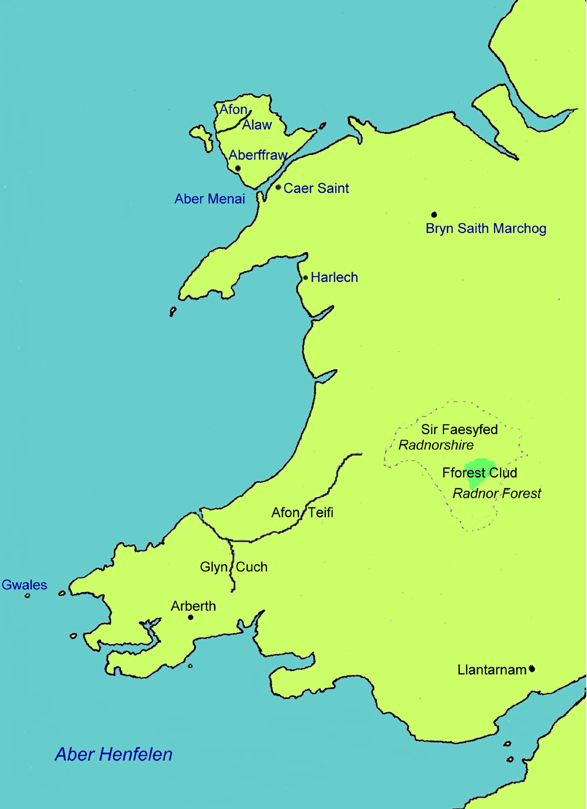
PRESELAU -
Preseli Mountains in Dyfed, full of prehistoric remains,
especially Pentre Ifan burial chamber (SN100360). The
place was important in the religious lives of people
in ancient times, and as it was so special, it is likely
that the Blue Stones were transported from Carn Menyn
(SN144325) in Preseli to Stonehenge (SU122422) on Salisbury
Plain in England.
GWENT
IS COED - (See the map of old Welsh land measurements  for further details) The Lordship of Teyrnon Twrf Liant. Some associate
his name with the Brittonic name Tigernonos, a Celtic
god, in form half man, half deer – “The Great King”.
In Welsh, twrf liant means roar of the sea. (Here
is another equestrian connection - After saving
his new-born colt from the monster, Teyrnon found
Rhiannon and Pwyll’s son Pryderi.) for further details) The Lordship of Teyrnon Twrf Liant. Some associate
his name with the Brittonic name Tigernonos, a Celtic
god, in form half man, half deer – “The Great King”.
In Welsh, twrf liant means roar of the sea. (Here
is another equestrian connection - After saving
his new-born colt from the monster, Teyrnon found
Rhiannon and Pwyll’s son Pryderi.)
NANT TEYRNON-
To be found about two miles north of Caerleon in Gwent,
where Llantarnam Abbey (ST313928) was built in 1179.
(See the Map of Branches 1 and 2, above).
SEISYLLWCH -
which includes:
Ystrad Tywi (3 hundreds/cantrefi) + Ceredigion (4 Hundreds/cantrefi
[3 in later times]). See
the map of old Welsh land measurements  . .
IMPORTANT DISCLAIMER: THIS LOCALITY INFORMATION IS FOR REFERENCE PURPOSES ONLY.
UNLESS THERE IS A PUBLIC RIGHT OF WAY, YOU SHOULD NOT
ATTEMPT TO VISIT ANY SITES LISTED WITHOUT THE PERMISSION
OF THE LAND HOLDERS.
|